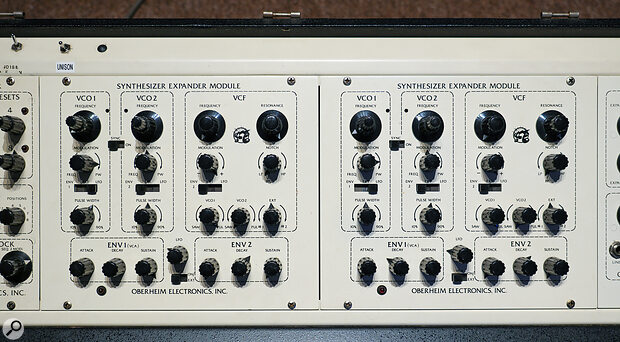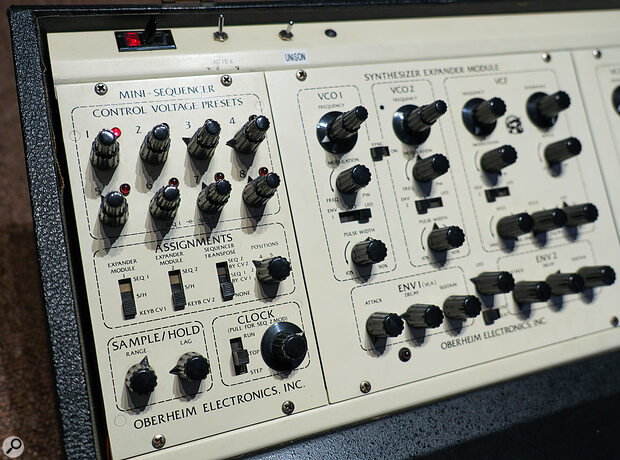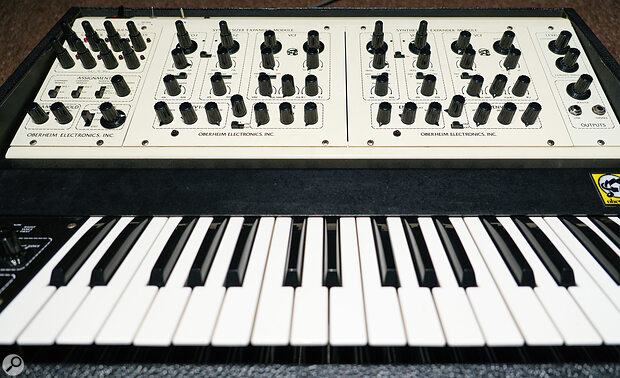If any synthesizer can be considered to be greater than the sum of its parts, it’s Tom Oberheim’s enduring classic, the Two Voice.
The Oberheim Two Voice (or TVS‑1) is one of Tom Oberheim’s favourite creations from his impressive back catalogue. Born out of a humble satellite unit designed by an all‑star cast of engineers, the Two Voice was the beginning of a line of synthesizers that have made an indelible mark in contemporary music.
An Engineer Finds Music
A Kansas native with an interest in electronics, Oberheim moved to LA with friends in the 1950s. As well as experiencing printed circuit boards for the first time whilst working for a camera shop, he also took a role as a draftsman for the electronics division of National Cash Register, who were one of the earliest companies to build computers.
Realising he needed to study further to get where he wanted to be in an ever-changing technological world, Oberheim returned to education, studying Physics at UCLA in his 20s. This, fatefully, included a side course in art and music. Developing an appreciation for music through his studies, Oberheim started singing in choirs, including the UCLA choir. This moved him into circles of musicians and one day, one such musician asked Oberheim if he could use his skills to build him a ring modulator. Not really knowing what a ring modulator even was, Oberheim found an article written by Harald Bode, famously a collaborator of Robert Moog, and successfully managed to build a working device in his apartment in Santa Monica.
Word of this must have spread as Oberheim then received a phone call from composer Leonard Rosenman, asking if he could bring a ring modulator down for use on a film he was scoring, which turned out to be Beneath The Planet Of The Apes. Whilst the ring modulator was only used on some piano parts, musicians in the orchestra were intrigued by the device and asked if he could sell them one so, still based in his apartment, he went into business.
Oberheim then got a call from Chicago Music Instruments (CMI), who’d also heard of his ring modulator and wanted to add it to their Maestro line of effects. And so it became the Maestro RM‑1, which is why both Oberheim and Maestro badged versions of the same effect can be found.
Spurred on, Oberheim then decided to try to build a pedal that emulated tape flange, but came across an example circuit for phase‑shifting using op‑amps and so built that instead. Again, Maestro added it to their line and it became the Maestro PS‑1A, which sold a staggering 70,000 units in the 1970s, putting Oberheim well and truly on the map.
Pulling on his earlier experience working with computers, Oberheim then designed one of the earliest digital synthesizer sequencers on the market in 1973. The DS‑2 stored control voltages in logic gates and could then play them back to reproduce the programmed sequence of notes. Unlike the first microprocessor‑controlled sequencers, such as the Roland MC‑8, there was no ability to copy and paste or sequence multiple tracks, but the possibility of storing 144 notes in a world of 16‑step sequencers was a big deal for the time.
For all its exciting potential, however, the DS‑2 created a problem: if a synthesist hooked up their synthesizer to it to play back a sequence, then what would the synthesist play? This realisation lead Oberheim to begin work on a satellite synthesizer unit that could be used with the DS‑2 whilst the synthesist played along on the keyboard of their main synth. For this idea to sell, the satellite unit needed to be as affordable as possible, but also have the minimum required to make it usable.
The resulting design was dubbed the Synthesizer Expander Module, or SEM for short. It contained two oscillators, a state‑variable filter, an amplifier, two envelopes and an LFO. Deliberately designed without a keyboard, the rear of the unit housed the jack points to connect it up to the DS‑2.
 The Two Voice recipe is simple: take two Synthesizer Expander Modules...
The Two Voice recipe is simple: take two Synthesizer Expander Modules...
Collaboration & Experimentation
In search of quality VCOs for the SEM concept, Oberheim approached E‑mu Systems, who were already deeply involved with innovations in both analogue and digital synthesizer design. Dave Rossum of E‑mu had previously cooked up some discrete VCOs for E‑mu’s own modular synthesizer and so, in turn, he designed discrete VCOs for the SEM.
E‑mu’s involvement didn’t stop there, however. Understanding the potential of digital technology, Rossum had been working on polyphonic keyboard designs, culminating in a microprocessor‑controlled scanning keyboard, possibly the first of its kind. This would prove fateful for Oberheim and the SEM, as we’ll discuss later.
Next on the shopping list was a filter. Oberheim already had connections with ARP Instruments as he’d approached co‑founder David Friend at a trade show and offered to be their West Coast dealer, which they’d take him up on as he had a good list of movie composers in his contact list. One of ARP’s (then Tonus’) first engineers was Dennis P Colin. A talented designer, Colin had a particular skill with filters and had created the 1047 Multimode Filter/Resonator for the ARP 2500. He’d written a paper on the science behind his design and Oberheim cut a deal and licensed use of the filter from him, which again proved fateful as it helped define the distinctive and desirable Oberheim sound.
Back at base, Oberheim had brought in Jim Cooper as a staff engineer, and he worked with him until the early ’80s when he left to form his own company and also become head of the MIDI Manufacturers Association. Cooper provided additional circuit designs for the SEM, including the triangle wave LFO.
Time has shown that his instincts were spot on, as the SEM is amongst the most emulated and copied analogue designs of all time.
With his main circuits in place, Oberheim set to work tweaking the design, changing component values and experimenting with how the electronics affected the sound. After some time he found the point where the SEM sounded as good as he could make it and from then on, SEMs were always made to that spec. Time has shown that his instincts were spot on, as the SEM is amongst the most emulated and copied analogue designs of all time.
 ...add an eight‑step mini‑sequencer...
...add an eight‑step mini‑sequencer...
Wait A Second...
The SEM went out into the world to pair with the DS‑2 as intended, but Oberheim had already put two and two together and realised that E‑mu’s digital keyboard could open the door for something much more ambitious. Since a polyphonic keyboard can send out discrete control voltage and gate signals, these could be connected to multiple SEM modules to create a polyphonic synthesizer! Oberheim had already had experience of a crude version of this, as he had modded ARP 2600s so that they could be played duophonically, albeit with the oscillators sharing a signal path. This was the opportunity to take that to a whole other level.
I had the great pleasure of speaking to Dave Rossum at Machina Bristronica in 2024 and in a conversation about this time he told me that Oberheim actually paid to get the patent sorted for the keyboard to speed up the production, and then licensed it back to E‑mu.
Armed with all the components, the end results were the Four Voice (FVS‑1) and the almighty Eight Voice (EVS‑1), the former being the first commercially available polyphonic synthesizer. But before either of those came the humble Two Voice (TVS‑1) in 1975.
Housed in a case containing two SEMs and the polyphonic keyboard, the Two Voice allowed the player to play both voices in unison or play two notes on the keyboard, and to choose the order of SEM that they were directed to with a ‘left voice first’ or ‘right voice first’ toggle switch. As a bonus, a two‑channel, eight‑step mini‑sequencer was housed in the left of the instrument, with the dual‑concentric knobs providing parallel control voltages. Much like the DS‑2/SEM concept, one SEM could be sequenced while the synthesist played the other from the keyboard, or as a bonus, sequences could be transposed from the keyboard, and/or the second sequencer channel could modulate the sequencer clock if the clock knob was pulled up.
One of the defining characteristics of the SEM is the 2‑pole state‑variable filter. As well as offering phasey notch filtering, vocal‑esque band‑pass filtering and fizzing high‑pass filtering, along with classic low‑pass, the SEM filter sounds better and better the more resonance is added. This is counter to numerous analogue filter designs that lose bass and become whistley as the resonance is cranked. Maxed out, the SEM filter still sounds superb and this was the basis of one of the most famous synth sounds of all time, the filter sweep on Rush’s ‘Tom Sawyer’. Whilst this was performed on the later Oberheim OB‑X, the filter was still the same SEM design and the sound is possible on the Two, Four and Eight Voice instruments with differing levels of unison stack.
 ...and an E‑mu keyboard and you’re done!
...and an E‑mu keyboard and you’re done!
Short But Sweet
In 1978, Dave Smith of Sequential Circuits famously flipped the synthesizer world on its head when he unveiled the Prophet‑5. Again, involving much technology from E‑mu Systems, the Prophet had a single set of front‑panel controls changing the parameters of all of the voices simultaneously, plus there was the massive breakthrough of proper patch storage. This was the opposite of Oberheim’s SEM‑based synthesizers, which had a full set of controls that needed to be manually set up for every voice, which equated to 160 knobs on the Eight Voice, just to change from one sound to another! Also, the only thing that resembled patch memory was a limited proto‑memory found in the Four and Eight Voice models that could store offset CV values for some parameters. Understandably, sales of Oberheim’s synths went immediately south following the announcement of the P5 and to keep up, SEM synths were abandoned and replaced with a new line of polyphonic synthesizers, the OB‑X, OB‑Xa and OB‑8, which are a story unto themselves. The SEM and its polyphonic pals were overnight dinosaurs and could have been lost to the 1970s as a relic of how things were achieved at that point in history. But instead, as the decades drifted on, demand for discontinued Oberheims started to rise and with that went the prices. With relatively few units made, the appetite for the ’70s Oberheim sound has lead to all manner of clones, ‘inspired bys’, sample packs and software emulations.
Having spent time away from the industry, Tom Oberheim began remaking SEMs in the 21st Century. This lead on to two new versions of the Two Voice, produced on a limited basis: firstly the Two Voice Pro in 2015, and secondly the Special Edition in 2021. Both units kept the main features of the original, but included updates and improvements for the modern world. The latter was also the first synth to reuse the Oberheim brand after it had been returned to Tom Oberheim.
A Life Of Its Own
Out in the world, SEM synths have appeared in many famous recordings and live performances from Stevie Wonder, Weather Report, Chick Corea, Herbie Hancock, John Carpenter, George Duke, Rush, Vangelis, Vince Clarke, the Prodigy, 808 State and Edgar Froese, amongst others, but the TVS‑1 has some specific appearances that are worth mentioning. Firstly, Mark Mothersbaugh used his unit for the sprinkling of electronic sounds and even entire electronic cues for the score to The Life Aquatic With Steve Zissou in 2004.
Meanwhile, on the other side of the Atlantic, Geoff Barrow and Ben Salisbury were originally hired to compose the music for the 2012 film Dredd and took the approach of a raw, minimal, dystopian synth score. They were subsequently replaced on the job by Paul Leonard‑Morgan, but were thankfully able to release their work as an album titled Drokk: Music Inspired by Mega‑City One. The unused score features heavy use of three original TVS‑1 units owned by the duo.
One other use worth mentioning is that of Michael Stein and Kyle Dixon. After much speculation as to which synth provided the distinctive arpeggio in their theme for Stranger Things, the band revealed that it was their Oberheim TVS‑1 and, furthermore, that the arpeggio was played by hand, rather than with a sequencer or arpeggiator.
Don Lewis & LEO
In the early ’70s, American musician Don Lewis (who’d already caught the attention of Roland’s future founder, Ikutaro Kakehashi, by modifying his Ace Tone Rhythm Aces) hatched an ambitious plan to make a synthesizer ensemble that could be controlled by a single person. The result was called the Live Electronic Orchestra, or LEO for short. Whilst Lewis and the LEO would prove inspirational for the later development of MIDI, there’s an interesting Oberheim connection entwined within. At around the same time that Tom Oberheim was working with E‑mu Systems to pair up his SEMs with their polyphonic keyboard, Lewis had worked with engineer Richard Bates, but also Armand Pascetta, who had also created a digital, polyphonic keyboard. One of the parts of LEO was a bank of four Oberheim SEMs that were controlled by Pascetta’s keyboard, meaning that the Oberheim Four Voice was, in essence, independently developed twice at the same moment in history! Lewis’ homebrew Four Voice can be heard on Sergio Mendes’ Homecooking and on the Brothers Johnson’s Look Out For #1, both recorded in 1976.

